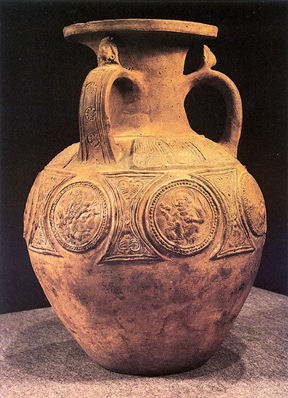
Said to have been found at Borazan near Khotan
5th-6th century CE
Terra cotta
Height: 45.0 cm.
Acquisition #: MIK III 7665
Image courtesy of the Museum für Indische Kunst (copyright reserved)
Staatliche Museen zu Berlin - Preussischer Kulturbesitz
This vase was reported as discovered at a site near Khotan, south of the Takla Makan Desert. While there is no way to determine the cultural identity of the vase's crafter with any real certainty, the decoration employed by the potter offers some clues for speculation.
Sogdian craftsmen and traders were a common site in the various oasis towns and Buddhist centers in Central Asia, including Khotan. During the 5th and 6th centuries both Sogdiana and virtually all oases of the Tarim Basin were under the control of the Hephthalites. But rather than restricting trade and movement, Sogdian merchants may have had more opportunities to travel safely within the Hephthalite sphere of influence once they had consolidated their military control.
The vase displays with a number of motifs, each derived from a different cultural source. The handles of the vase are decorated with female heads in typical Hellenist style (one of the handles has broken off). Four of the eight medallions encircling the body depict female figures dressed and posed in a manner that recalls the Indian yakshi, a type of fertility spirit, in Kushan style. Three other medallions depict bald and bearded male figures; the first holds a nimbus, the second an Iranian-style drinking horn known as a rhyton, while the third bears a goblet in his hand. The last of the medallions is the only one that does not feature a human figure, and is decorated with a lion's head. This coalescence of Greco-Roman, Kushan and Sassanian motifs is a common characteristic of Sogdian art.